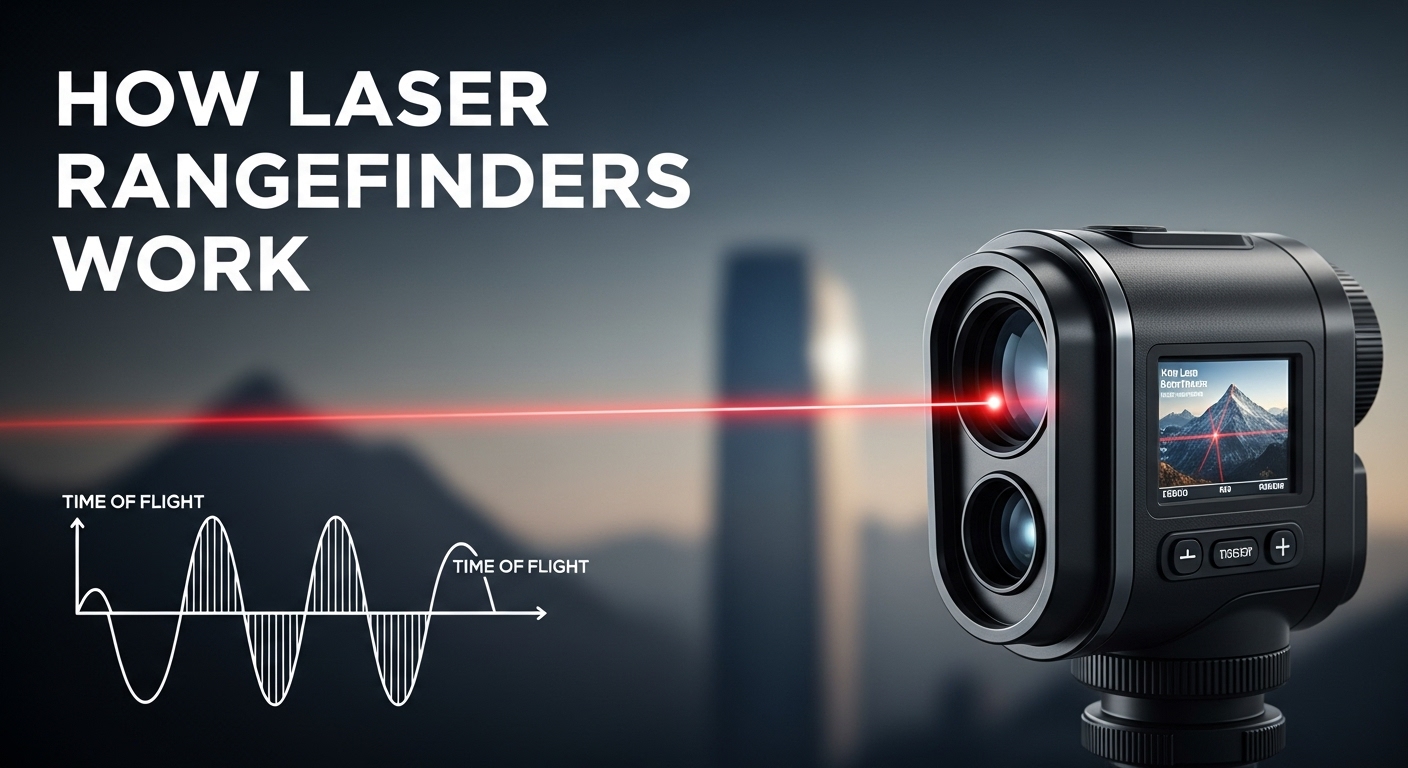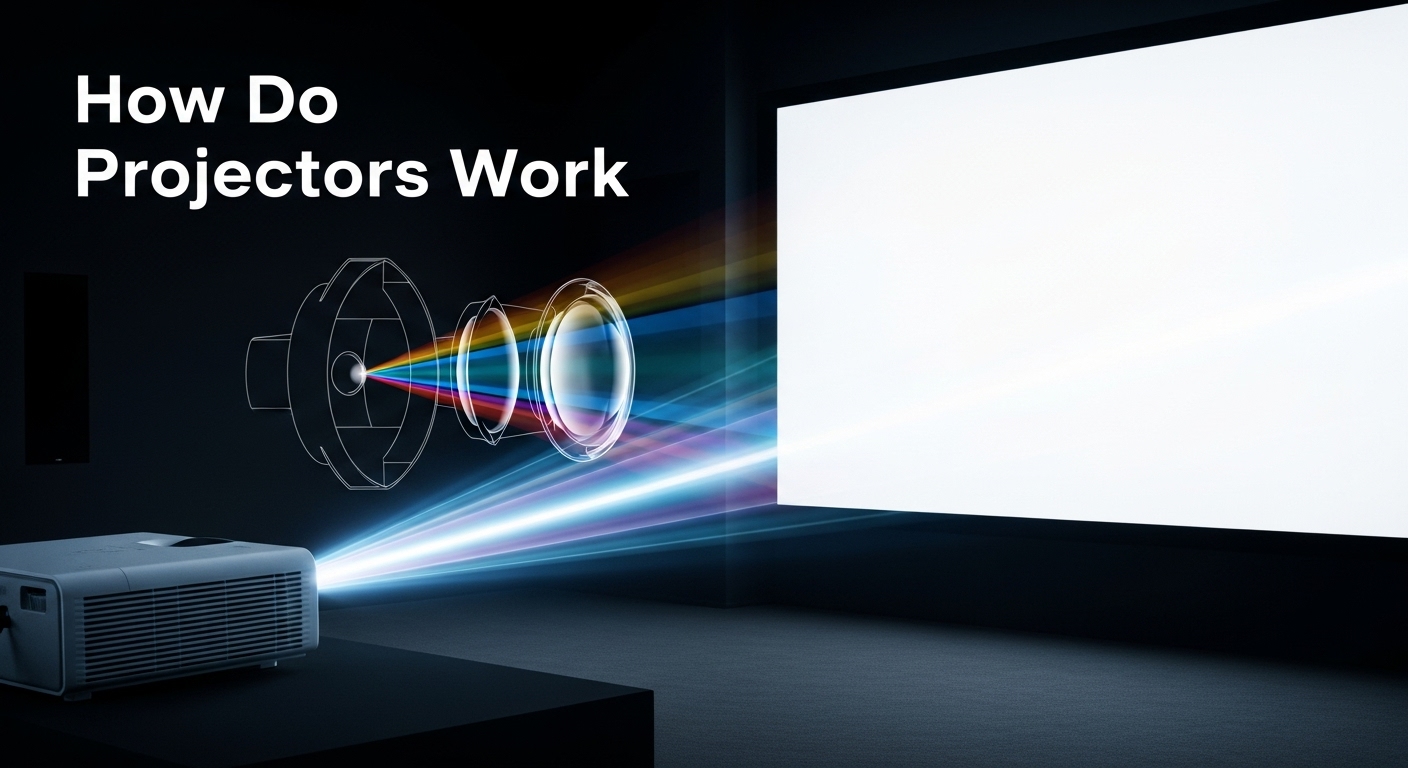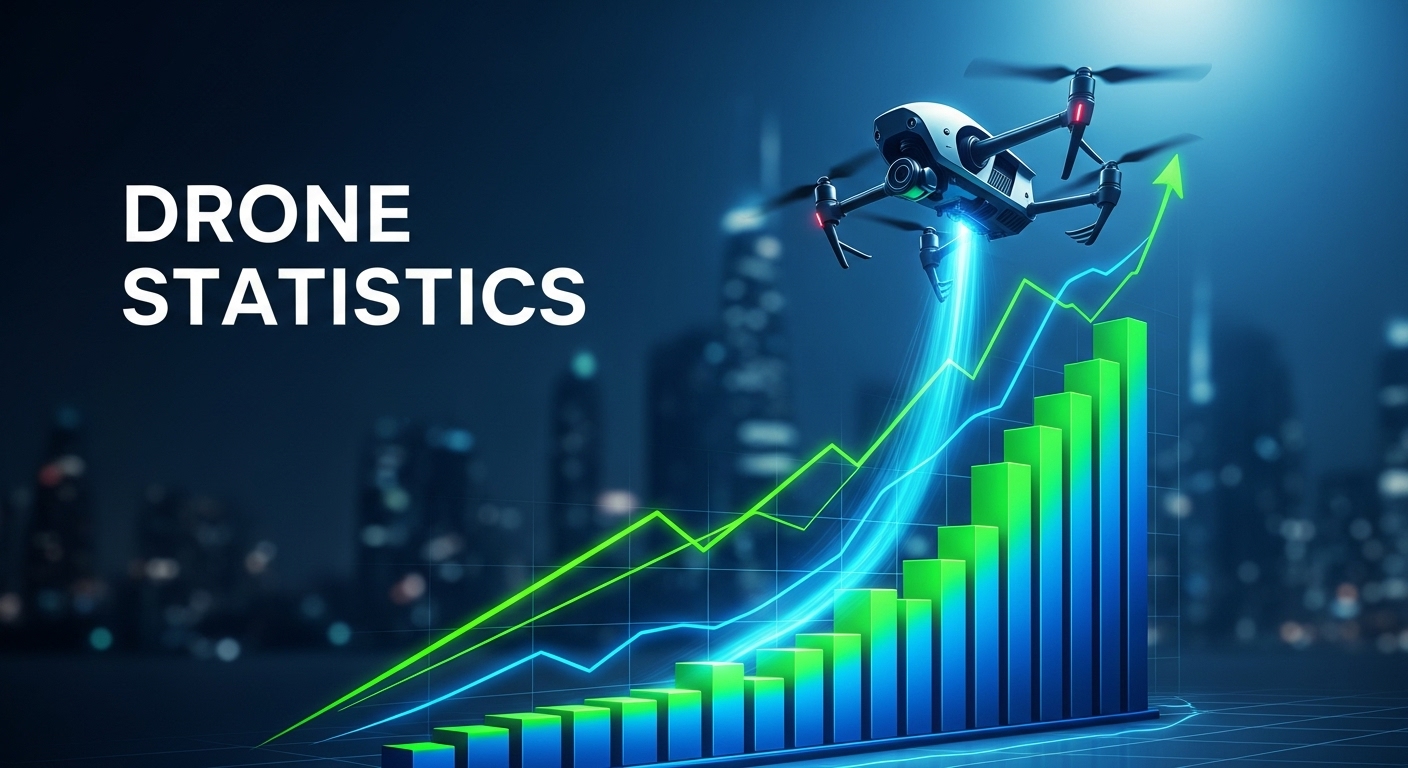



Laser rangefinders have revolutionized how we measure distance with incredible precision. These devices use the fundamental properties of light to calculate exact distances to targets hundreds or even thousands of yards away. From construction sites to golf courses and battlefields, laser rangefinders have become essential tools for professionals and enthusiasts who need accurate distance measurements.
How laser rangefinders work is based on a simple yet elegant principle: they emit a laser pulse toward a target and measure the time it takes for the light to reflect back. By knowing that light travels at approximately 299,792 kilometers per second (186,282 miles per second), the rangefinder can calculate the distance with remarkable accuracy using the formula: Distance = (Speed of Light × Time) ÷ 2.
This comprehensive guide will walk you through everything you need to know about laser rangefinder technology, from the basic physics principles to advanced applications across various industries. We’ll explore the technical components that make these devices work, compare different measurement methods, and help you understand the factors that affect their performance in real-world conditions.
The time-of-flight (TOF) principle is the cornerstone of how most laser rangefinders work. This elegant concept relies on one of the universe’s most fundamental constants: the speed of light. By measuring how long it takes for a laser pulse to travel to a target and back, rangefinders can calculate distances with incredible precision.
Here’s how laser rangefinders work using the time-of-flight method:
Time of Flight: The measurement principle using the time for a laser pulse to travel to a target and return, enabling precise distance calculations based on the constant speed of light.
The incredible speed of light makes this measurement possible. Light travels approximately 1 foot (30.48 cm) in just 1 nanosecond. This means that to measure distances accurately to within 1 yard (0.91 meters), the rangefinder’s timing system must be accurate to within about 6 picoseconds – a truly remarkable feat of engineering.
While time-of-flight is the most common method for laser rangefinding, particularly for long distances, there’s another important technique used in many applications: the phase shift method. Each approach has distinct advantages and ideal use cases.
| Feature | Time-of-Flight Method | Phase Shift Method |
|---|---|---|
| Range Capability | Up to 25+ kilometers | Typically under 100 meters |
| Accuracy | ±1 to ±10 meters | ±1 to ±2 millimeters |
| Measurement Speed | 0.5 to 2 seconds | Multiple measurements per second |
| Complexity | High-speed timing required | Complex signal processing |
| Cost | Higher for long-range models | Lower for short-range models |
| Best Applications | Long-distance measurement, outdoor use | Industrial measurement, construction |
Time-of-flight rangefinders work by measuring the actual travel time of discrete laser pulses. This method excels at long-distance measurements because individual pulses maintain their integrity over extended ranges. Military-grade rangefinders using TOF can measure distances beyond 20 kilometers with appropriate targets and conditions.
The key advantage of TOF is its ability to measure long distances with reasonable accuracy. However, achieving high precision at shorter distances requires extremely fast timing electronics, which can increase costs. This is why consumer-grade rangefinders typically have accuracies of ±1 yard or meter.
Phase shift rangefinders work differently – they emit a continuous laser beam that’s modulated at a specific frequency. By measuring the phase difference between the emitted and reflected light, these devices can calculate distance with exceptional precision.
Imagine the laser beam as a wave. When it reflects off a target and returns, the wave’s phase has shifted based on the distance traveled. By measuring this phase shift very precisely, the rangefinder can determine distance with millimeter-level accuracy.
The phase shift method is ideal for industrial applications, construction surveys, and manufacturing processes where high precision at relatively short distances is crucial. These devices can take multiple measurements per second, making them excellent for dynamic applications.
Phase Shift Method: Alternative measurement technique using phase differences in modulated laser light, offering extremely high accuracy at shorter distances but with limited range capability.
Many modern professional rangefinders combine both methods, using phase shift for high-precision short measurements and time-of-flight for longer distances, providing versatility across different applications.
Understanding how laser rangefinders work requires examining their key components. Each part plays a crucial role in achieving accurate distance measurements, and advances in these components have driven the remarkable improvements in rangefinder performance over the past decade.
The heart of any laser rangefinder is its laser diode, which generates the coherent light beam used for measurement. Most consumer rangefinders use semiconductor laser diodes that emit infrared light at wavelengths of 905nm or 1550nm.
The 905nm wavelength offers advantages in cost and efficiency but requires careful safety design as it’s near the visible spectrum. The 1550nm wavelength is eye-safe at higher power levels because it’s strongly absorbed by the eye’s cornea and lens, making it ideal for military and industrial applications where higher power is needed.
Modern laser diodes can produce incredibly short pulses – some as brief as 10 nanoseconds. This short pulse duration is crucial for accurate distance measurement as it creates a clear start and stop point for the timing system.
The optical system in a laser rangefinder does more than just aim the beam – it shapes and controls the laser light to optimize performance. High-quality lenses and mirrors focus the laser beam into a tight, collimated beam that minimizes spread over distance.
Beam divergence – the spreading of the laser beam as it travels – is a critical specification. Lower beam divergence means the laser spot remains smaller at long distances, improving accuracy on small targets. Professional rangefinders might have beam divergence as low as 0.5 milliradians, creating a spot only 1.6 feet (0.5 meters) wide at 1000 yards.
The receiver optics are equally important. They collect the returning light and focus it onto the photodetector. Larger receiver apertures can gather more light, improving performance on distant or low-reflectivity targets.
The photodetector is the rangefinder’s “eye” – it must detect incredibly weak return signals from distant targets. Most modern rangefinders use avalanche photodiodes (APDs), which provide internal signal amplification.
When a photon hits the APD, it creates an electron avalanche effect, multiplying the signal thousands of times. This amplification is essential for detecting the few photons that make it back from distant targets. Some military-grade rangefinders even use photomultiplier tubes for maximum sensitivity.
The signal processing electronics analyze the detected signal, filtering out noise and identifying the true return pulse. Advanced algorithms can distinguish between multiple returns – useful for identifying the closest target in a cluttered environment or measuring through partial obstructions.
The timing system is where the magic happens. Modern rangefinders use crystal oscillators or atomic references to create incredibly stable time bases. Some high-end systems incorporate temperature-compensated crystal oscillators (TCXOs) that maintain accuracy across a wide temperature range.
Time-to-digital converters (TDCs) measure the elapsed time with picosecond precision. These specialized integrated circuits can resolve time differences down to 10-20 picoseconds, enabling meter-level accuracy at distances of several kilometers.
Many rangefinders incorporate multiple measurements and statistical analysis to improve accuracy. By taking several readings and applying algorithms, they can filter out atmospheric effects and random noise, providing more consistent and reliable distance measurements.
While laser rangefinders are remarkably capable devices, their performance can be affected by various environmental and technical factors. Understanding these limitations helps users get the most accurate measurements and choose the right rangefinder for their specific needs.
Beam Divergence: The spreading of the laser beam as it travels, affecting accuracy and target coverage. Lower beam divergence provides better performance on small, distant targets.
The atmosphere between the rangefinder and target can significantly affect measurement accuracy. Temperature gradients cause refraction – bending of the laser beam – which can make targets appear closer or farther than they actually are. This effect is most noticeable over long distances or when measuring across temperature differentials.
Fog, rain, snow, and dust particles in the air can scatter or absorb laser light, reducing the strength of the return signal. Heavy precipitation can reduce effective range by 50% or more. Some military rangefinders use multiple wavelengths to help compensate for atmospheric effects.
Humidity also affects laser transmission. Water vapor in the air absorbs some infrared wavelengths, slightly reducing range and accuracy. This effect is usually minor at typical rangefinding distances but becomes more significant over several kilometers.
The target’s properties play a crucial role in rangefinder performance. Reflectivity is perhaps the most important factor – a white painted surface might reflect 90% of incident light, while a black, non-reflective surface might absorb 95% of it.
The angle of the target surface relative to the rangefinder affects how much light returns directly to the device. Perpendicular surfaces provide the best returns, while surfaces at 45 degrees or more may return insufficient signal for accurate measurement.
Target size matters too. Smaller targets may not fully capture the laser beam, especially at long distances where beam divergence creates a larger spot size. This is why some rangefinders struggle with small targets like golf pins beyond 200-300 yards.
Bright sunlight can sometimes interfere with rangefinder performance, particularly when measuring distant, low-reflectivity targets. The ambient light can overwhelm the photodetector, making it harder to detect the weak return signal. Many rangefinders use optical filters to block visible light and only pass the specific laser wavelength.
Heat haze or shimmer, common on hot days or over warm surfaces, can distort the laser beam and affect accuracy. This effect is caused by temperature variations in the air creating refractive index differences that bend the light path.
Altitude affects rangefinder performance through air density. At higher altitudes, thinner air provides less scattering and absorption, potentially increasing effective range. Conversely, denser air at lower altitudes or near water bodies can reduce performance.
Even the best rangefinders have inherent technical limitations. The timing electronics have finite resolution, creating a minimum distance increment. Most consumer rangefinders measure in 0.5 or 1-yard increments, while professional models might offer 0.1-meter precision.
Maximum range is limited by laser power (restricted by safety considerations), detector sensitivity, and atmospheric conditions. Consumer rangefinders typically max out at 500-1500 yards, while military models can reach 20+ kilometers with appropriate targets.
Close-range performance can also be limited. Most rangefinders have a minimum distance of 5-10 yards because the electronics need time to reset between pulse emission and detection. Some specialized models use different techniques for very short range measurements.
Laser rangefinders have found applications across dozens of industries, each with specific requirements and challenges. The versatility of laser ranging technology has made it indispensable in fields ranging from sports to military operations.
In golf, laser rangefinders help players determine exact distances to pins, hazards, and landmarks. Golf rangefinders typically offer magnification of 5-7x and ranges up to 1000 yards, with special features like pin-seeking technology that isolates the flagstick from background objects.
Hunters use rangefinders to judge distances to game, crucial for accurate shot placement. Rangefinders for bow hunting often feature angle compensation that calculates the true horizontal distance, important when shooting from elevated positions like tree stands.
Understanding the differences between golf and hunting rangefinders helps users choose the right model. Golf rangefinders prioritize pin-seeking and close-range accuracy, while hunting models emphasize longer range, durability, and performance in low light conditions.
Professional surveyors rely on laser rangefinders for rapid distance measurements in site surveys and layout work. These professional-grade devices offer millimeter-level accuracy and can integrate with GPS systems and data collection software.
Construction workers use rangefinders for everything from calculating material quantities to verifying dimensions. Laser distance meters have largely replaced tape measures for many applications due to their speed and accuracy, especially for long measurements where a single person can measure distances that would previously require two people.
Military applications represent some of the most demanding rangefinder requirements. Military rangefinders must provide accurate distance measurements for target acquisition, artillery spotting, and reconnaissance missions.
These devices often combine rangefinding with other capabilities like compasses, GPS, and night vision. Military-grade rangefinders can measure distances beyond 20 kilometers, incorporate eye-safe high-power lasers, and are built to withstand extreme environmental conditions.
In industrial automation, laser rangefinders measure distances for process control, robotics positioning, and quality control. These applications often require high precision and reliability rather than long range.
Forestry professionals use rangefinders for tree height measurements and timber volume estimation. Specialized forestry rangefinders can calculate tree height based on angle and distance measurements, eliminating the need for dangerous climbing.
Wildlife researchers use rangefinders to maintain safe distances from animals while collecting accurate behavioral data. Some models include built-in compasses and inclinometers for complete spatial positioning information.
While laser rangefinders are generally safe when used as intended, they do contain lasers that require proper handling. Understanding laser safety is essential, especially for professional users who operate these devices regularly.
Most consumer laser rangefinders use Class 1 or Class 1M lasers, which are considered eye-safe under normal use conditions. Class 1 lasers are safe in all conceivable use situations, while Class 1M lasers are safe for normal viewing but may be hazardous if viewed with optical instruments like binoculars or telescopes.
Some professional and military rangefinders use Class 3R or Class 3B lasers, which can be hazardous if the beam enters the eye directly. These devices require special training and safety precautions, including avoiding aiming at people and using appropriate eye protection when necessary.
Best practices for safe rangefinder use include:
Laser rangefinder technology continues to evolve rapidly, with advances in miniaturization, signal processing, and integration with other technologies. The future promises even more capable and accessible distance measurement solutions.
Artificial intelligence is beginning to play a role in advanced rangefinders. AI-powered target recognition can identify specific objects, filter out unwanted returns, and even predict target movement. This technology is particularly valuable in military and wildlife monitoring applications.
Integration with augmented reality (AR) systems is an emerging trend. AR rangefinders can overlay distance information directly onto the user’s field of view, providing intuitive distance visualization without looking away from the target.
Advances in photonic integration are enabling smaller, more efficient rangefinders. Future devices may be incorporated into smartphones, drones, and other everyday tools, making precise distance measurement universally accessible.
New laser technologies, such as frequency combs and quantum cascade lasers, promise to improve both accuracy and range. These advanced light sources could enable millimeter-level accuracy at kilometer distances, opening new possibilities for scientific and industrial applications.
As laser rangefinder technology continues to advance, these devices will become even more integral to how we measure and interact with our environment. From construction sites to golf courses, battlefields to wildlife preserves, the fundamental principle of measuring light’s travel time will continue to provide accurate, reliable distance measurements for countless applications.
The elegance of laser rangefinding lies in its simplicity – using one of nature’s constants, the speed of light, to measure distance with remarkable precision. As we’ve seen, the technology behind this simple concept is quite sophisticated, involving advanced optics, electronics, and signal processing. Understanding how laser rangefinders work not only satisfies technical curiosity but also helps users choose and operate these remarkable devices more effectively.
Laser rangefinder accuracy typically ranges from ±1 yard/meter for consumer models to ±0.1 meter for professional surveying equipment. Military rangefinders can achieve ±1 meter accuracy at distances over 20 kilometers. Accuracy depends on target characteristics, atmospheric conditions, and the quality of the rangefinder’s timing electronics.
Consumer laser rangefinders typically measure distances from 5-10 yards up to 500-1500 yards depending on the model and target reflectivity. Professional surveying rangefinders can reach 2-5 kilometers, while military-grade systems can measure beyond 20 kilometers with appropriate targets and clear atmospheric conditions.
Most consumer laser rangefinders use Class 1 or Class 1M lasers, which are considered eye-safe under normal use conditions. Class 1 lasers are safe in all situations, while Class 1M lasers are safe for normal viewing but may be hazardous if viewed with optical instruments. Professional models may use higher-power lasers requiring additional safety precautions.
Key factors affecting performance include atmospheric conditions (fog, rain, heat haze), target characteristics (reflectivity, size, angle), bright sunlight, and beam divergence. Temperature extremes can affect battery life and electronics performance. Higher altitude can improve range due to thinner air, while humidity can reduce maximum effective range.
Laser rangefinders typically cannot measure accurately through glass or other transparent materials. Glass reflects a portion of the laser light, causing the rangefinder to measure the distance to the glass rather than the target beyond. Some rangefinders have special modes that can ignore very close returns, but generally, you need an unobstructed line of sight to the target for accurate measurements.
Laser rangefinders use light and can measure longer distances with higher accuracy, while ultrasonic devices use sound waves and are limited to shorter ranges. Laser rangefinders work over hundreds or thousands of yards with ±1 meter accuracy, while ultrasonic meters typically work under 50 feet with ±1 inch accuracy. Lasers require a direct line of sight, while ultrasonic devices can work around some obstructions.







